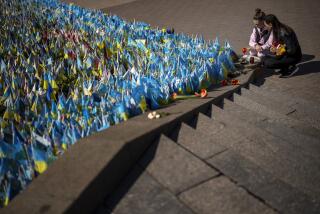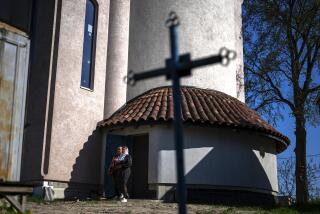Tombstones Define Dying Shtetl in Ukraine
SHARGOROD, Ukraine — A name like Sergei Shargorodsky is a password in Shargorod.
Locals immediately start wondering whether you’re related to that man who lives on Karl Marx Street, or maybe the woman over on Lenin Street. You try to explain that your ancestors came from Shargorod, that you’ve never been here before, that you don’t know--but the words go unheeded.
Maybe some distant, unknown relatives live here, the old people helpfully suggest.
“We have some Shargorodskys here,” says Maria Yakovlevna, an elderly woman tending Shargorod’s Jewish cemetery.
The tombstones are everywhere. Old ones jut out of the high grass at awkward angles. The graves overlook the green rolling hills--Ukraine’s blood-soaked black earth under the perfect dome of its vast blue skies.
In the new cemetery, sumptuous marble slabs with portraits of the dead stare out in silence: Shargorod’s picture gallery.
“Don’t you have a yarmulke? There you are. They sent it from Israel,” says my 67-year-old guide, Yihil Pogranichny, who puts a soiled skullcap on my head.
Then, mixing Yiddish, Russian and Ukrainian, he asks for money, “for the poor, you know, a lot of old lonely people here.”
Shargorod is lucky most of its relics remain intact. Its old tombstones were not used as construction material, a widespread Soviet practice.
For Rita Sokiryanskaya, a pensioner who runs the Jewish lecture society in the regional center of Vinnitsa, that is something to cherish.
“A Jewish cemetery was destroyed in Vinnitsa after the war to make room for a college dormitory,” she says. “My most terrible memory is of that steam shovel throwing out bones. Once I saw young boys playing soccer with a human skull.”
*
My family’s origins were in this town, from which they took their last name. I wanted to see where we had come from, to see what was left.
Founded in the late 16th century, this town 190 miles southwest of Kiev is one of the few remaining “shtetls”--the settlements where Jews were forced to live in imperial Russia.
These townships saw anti-Semitic massacres in the 17th and 18th centuries; the birth of Hassidism, one of the most powerful spiritual movements in modern Jewish history; and the hardships of the 19th century, when Jews were confined to the region called the “Pale of Settlement.”
The 1917 Bolshevik Revolution and the Russian Civil War, World War II and Soviet rule dealt the shtetls a mortal blow.
Today, it seems only the names on the graves remain--Bratslav, Uman, Nemirov, Bershad, Shepetovka.
Somewhere around here my grandfather, then a teenager, was jailed by anti-Bolshevik “whites” for being a member of the revolutionary underground. He was soon freed by the advancing Red Army and joined its fierce and legendary cavalry.
Most of Shargorod’s Jews, once more than 70% of the populace, are elderly. The young have moved to other parts of the former Soviet Union or have left for Israel or the United States.
“Once, we used to have 3,500 Jews, and now there are only 160 left. They are all gone,” says Shargorod’s administration chief, Ivan Karlashchuk.
The shtetls’ fate mirrors that of the Ukrainian Jews, who numbered 1.5 million before World War II and the Nazi Holocaust. Today, there are only half a million, including non-Jewish family members.
*
Shargorod’s synagogue, built in 1589, is a testimony to past glory with its white, fortified walls. The Soviets turned it into a liquor factory. A labyrinth of metal vats now conceals the carved stone columns inside.
The town’s Jewish streets, still bearing Communist-era names, are a time machine, an open-air museum. But there are people living in some of these decrepit one-story houses.
A small Jewish woman named Klara leads me to her home. The family makes passport photographs and types documents for fees. A large framed black and white photo of Klara’s old Soviet typewriter decorates the door.
Two cramped rooms. A stale smell. Turns out Klara’s husband wants to sell me some remnants of Hebrew books, long eaten by worms and mice. He cannot read them.
Pogranichny, my guide at the cemetery, later takes me in tow again. “Come, we have this hut; it’s like a museum.”
Inside, Zinovy Kreditor and his wife, Pesya, are packing up. The elderly couple are leaving for Israel, where Pesya’s sister lives. Some household items are displayed for sale.
Another room has long wooden benches, yellowing Israeli posters that once projected sunny optimism and boards with handwritten recollections about Shargorod during the war.
*
The war. Shargorod was occupied by Romanian troops allied with Nazi Germany. That was a break for the town. The Romanians brought in some of their own Jews, but limited themselves to harassment and beatings.
Pogranichny remembers it vividly.
“There used to be a ghetto here during the war. The Romanians put barbed wire around these streets and made us stay inside. Many people died of hunger. But they were not killing us, like the Germans did,” he says.
German troops who occupied nearby areas slaughtered hundreds of thousands of Jews.
*
Before the Soviet collapse, Shargorod was designated as a historic site, but Ukraine has no money to preserve the town. As for Jewish donations, community leaders say these are better spent on education or feeding the thousands of poor, elderly Jews.
“It’s impossible to save Shargorod,” says Leonid Finberg, head of Kiev’s Jewish Institute. “At one point, I considered it to be terribly important, but I no longer think so. One must realize that the value of human life, or of educating a child, is much more precious. So let it be as it would.”
It’s a slowly disappearing world. The young are going away, leaving the elderly behind, and the newborn can’t offset the death rate.
“It’s a drying branch of the Jewish tree,” Finberg says. “But it’s important to let this branch dry out quietly by itself. Maybe 50, 100 years will pass, but nobody should cut it off by force.”
More to Read
Sign up for Essential California
The most important California stories and recommendations in your inbox every morning.
You may occasionally receive promotional content from the Los Angeles Times.










